Vintage War Birds from Lone Star Flight Museum
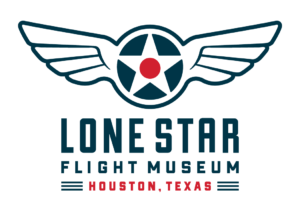 The single BIGGEST survey request, every year, is vintage warbirds. Some of the most immaculate vintage warbirds at the CAF Wings Over Houston Airshow come courtesy of the Lone Star Flight Museum.
The single BIGGEST survey request, every year, is vintage warbirds. Some of the most immaculate vintage warbirds at the CAF Wings Over Houston Airshow come courtesy of the Lone Star Flight Museum.
In September last year, the Lone Star Flight Museum moved to the Ellington Airport. This Insider email features the Lone Star Flight Museum and some of their most prestigious aircraft.
About Lone Star Flight Museum
The Lone Star Flight Museum (LSFM) opened the doors of its new $38 million, 130,000 square-foot aviation history and STEM learning facility in the fall of 2017. The world-class facility shares the story of flight in the Lone Star State and features the contributions Texas and Texans have made to aviation. Highlights of the museum include the Texas Aviation Hall of Fame, the Museum’s renowned flying collection of historic aircraft, the $1 million, high-tech Aviation Learning Center and dynamic hands-on exhibits. Aircraft on display includes the museum’s B-17, B-25, DC-3, P-47, SBD, F4U, TBM, T-6 and Stearman, along with many other visiting aircraft.
Get More Information on Lone Star Flight Museum:
Here are some of the Lone Star Flight Museum aircraft that will be featured (both flying and on the ground) at the 2018 Wings Over Houston Airshow.
A-1D Skyraider
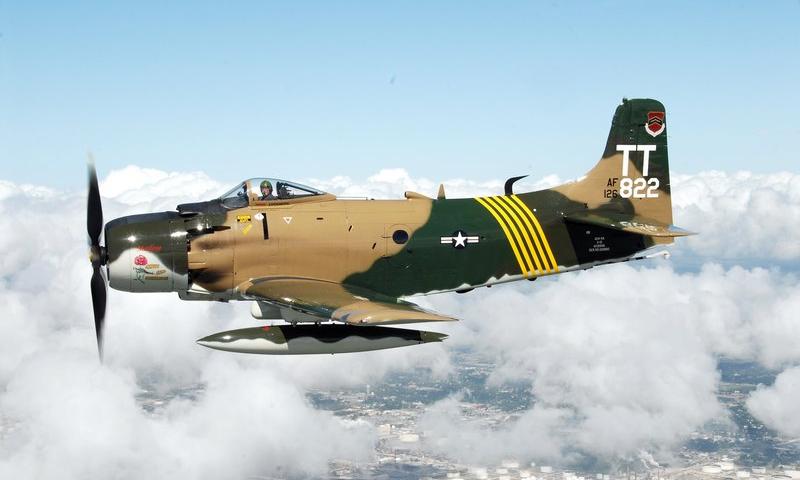
The prototype of the Skyraider was first flown on 18 March 1945. Designed as a robust, multi-role attack aircraft for the US Navy, the carrier-based Skyraider was able to carry a wide variety of weapons on its numerous wing hard points. It is well known for its ability to carry more ordinance than a World War II B-17. The first Skyraider was delivered in 1946 and named according to the Douglas tradition of starting the names of Navy aircraft with “sky.” Before production ceased in 1957, Douglas built 3,180 Skyraiders in 28 variations. The Skyraider first saw combat in the Korean War, where its long loiter time and heavy load-hauling capability gave it a distinct utility advantage over the jet aircraft of the time
B-17 Flying Fortress
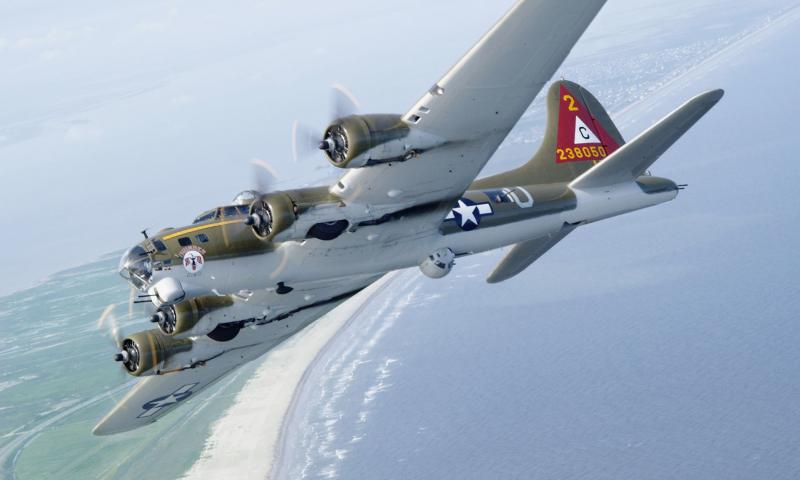 Perhaps no other aircraft more epitomized the air war against Nazi Germany than the Boeing B-17 Flying Fortress. While British bombers struck during the night, the legendary B-17 led the Allies’ daylight strategic bombing effort against Hitler’s Fortress Europe, conducting a twenty-four hour campaign to destroy Germany’s war-making ability.
Perhaps no other aircraft more epitomized the air war against Nazi Germany than the Boeing B-17 Flying Fortress. While British bombers struck during the night, the legendary B-17 led the Allies’ daylight strategic bombing effort against Hitler’s Fortress Europe, conducting a twenty-four hour campaign to destroy Germany’s war-making ability.
P-47 Thunderbolt
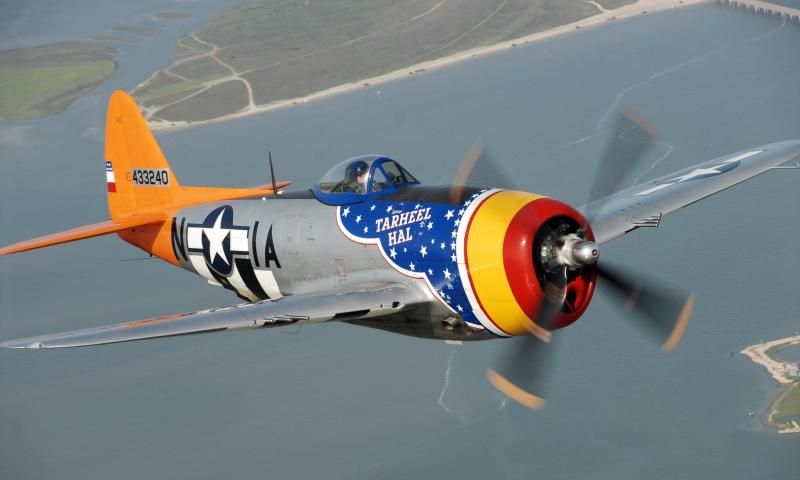
The Thunderbolt was the brainchild of Republic Aircraft’s chief designer, Alexander Kartveli. His challenge was to meet a 1940 Army Air Corps demand for a high speed, high altitude fighter with immense firepower. Republic had been developing the P-44, follow-on to its P-43 Lancer, but Kartveli realized it would fall far short of Army requirements. Kartveli molded the P-43’s lines into a new design patterned around the V-block Allison V-1710 engine. It later became clear that the new fighter, designated P-47, would never reach its potential with the under-powered Allison and it was replaced with a Pratt & Whitney R-2800 Double Wasp radial mated to a turbocharger for high altitude performance. To take advantage of the powerful R-2800, Republic fitted an immense four-bladed propeller. With an armament consisting of eight .50-inch machine guns, maximum speed of well over 400 mph, and a maximum ceiling of 40,000 feet, the Thunderbolt was just what the Air Corps was looking for in a fighter.
B-25 Mitchell
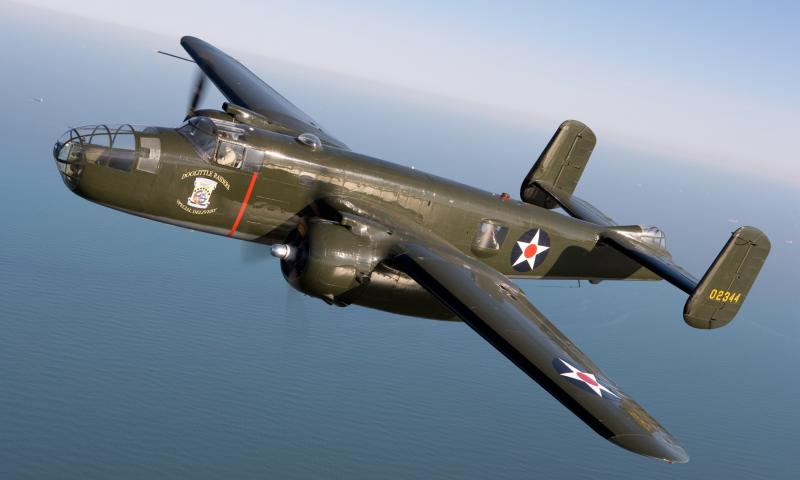
North American Aviation’s design of a twin-engine medium bomber was approved by the Army Air Corps in September 1939, and the prototype made its maiden flight less than a year later on 19 August 1940. Christened Mitchell in honor of Billy Mitchell, the American champion of air power theory, the B-25 would become the most widely-produced American twin-engine combat aircraft of World War II.
F4U Corsair
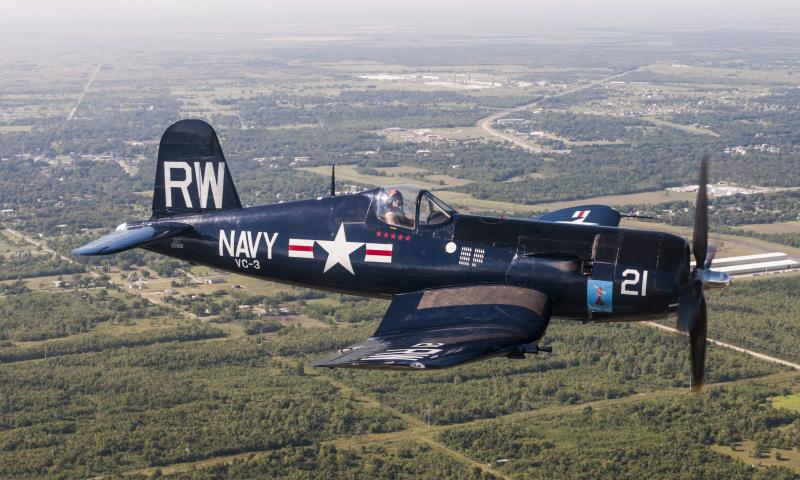 Chance Vought Aircraft Corporation contracted with the US Navy for a single prototype fighter aircraft in June 1938. Vought engineers selected the new 2,000 horsepower Pratt & Whitney R2800 engine for the project that would become the Corsair. The powerful engine required a large 14-foot diameter propeller, which necessitated changes in the design to assure ground clearance was met during carrier landings. These changes gave the Corsair its distinctive inverted gull wing shape by placing the landing gear at the lowest point on the wing making the gear more compact and robust. The Corsair made its maiden flight on 29 May 1940 and later became the first American fighter to exceed the 400-mph mark.
Chance Vought Aircraft Corporation contracted with the US Navy for a single prototype fighter aircraft in June 1938. Vought engineers selected the new 2,000 horsepower Pratt & Whitney R2800 engine for the project that would become the Corsair. The powerful engine required a large 14-foot diameter propeller, which necessitated changes in the design to assure ground clearance was met during carrier landings. These changes gave the Corsair its distinctive inverted gull wing shape by placing the landing gear at the lowest point on the wing making the gear more compact and robust. The Corsair made its maiden flight on 29 May 1940 and later became the first American fighter to exceed the 400-mph mark.
Don’t Pay the GATE PRICE … SAVE UP to 12% OFF* Airshow Tickets as an Insider when you BUY ONLINE!
Please Don’t Pay the Gate Price – Use the Button Below to Buy ONLINE & SAVE! This year’s airshow features the United States Navy Blue Angels!
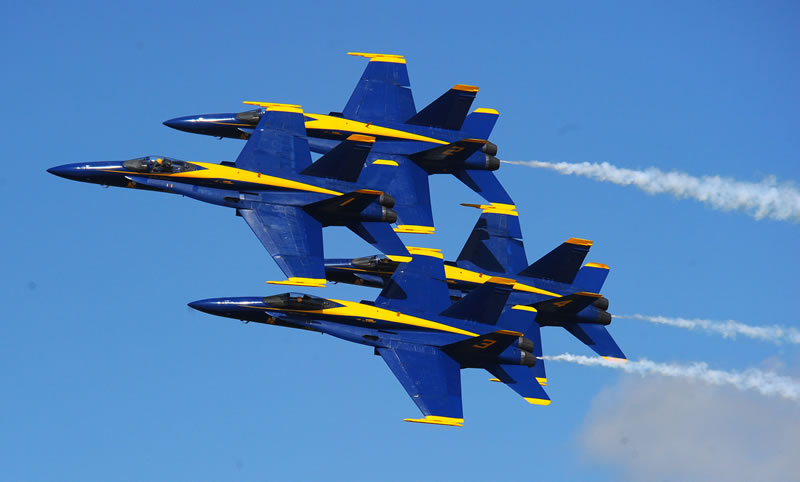 Important note: Your Insider ONLY discount is automatically applied to any tickets you select during the checkout process. The prices you see in the cart are discounted INSIDER ONLY prices. Just click below and select your tickets.
Important note: Your Insider ONLY discount is automatically applied to any tickets you select during the checkout process. The prices you see in the cart are discounted INSIDER ONLY prices. Just click below and select your tickets.
 * Service Fees may be applicable
* Service Fees may be applicable
Note: All performers and participants are subject to change without notice. If anything does change, we’ll do our best to let you know. Thank you!
Your Privacy is of paramount importance to us. Be sure to review our updated privacy policy for more details.
Photo and Information Credits:
Lone Star Flight Museum
